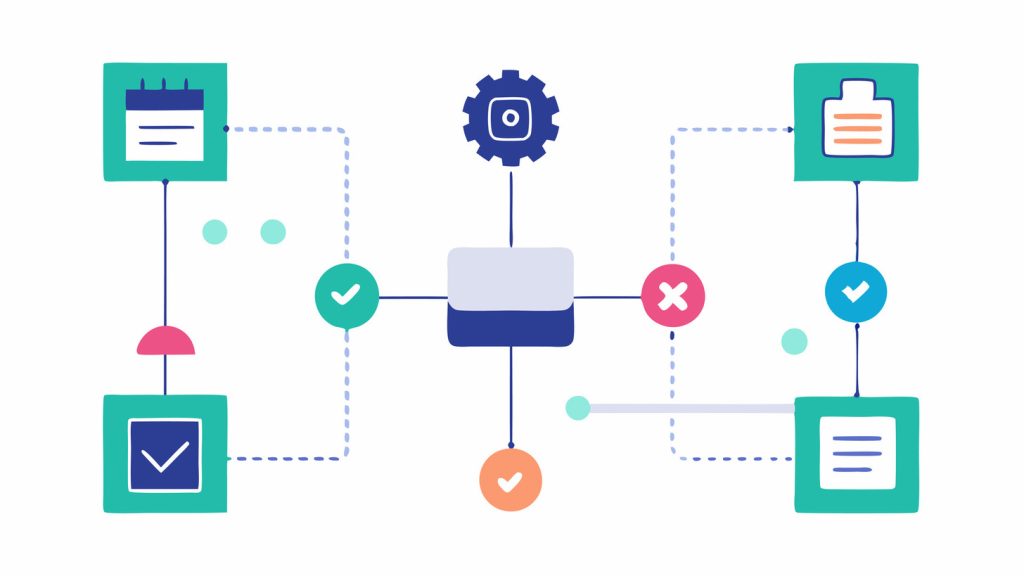Streamline Operations with Our Integrations Directory

Modern businesses rely on interconnected tools to stay efficient. Disconnected systems create delays, errors, and missed opportunities. A centralized hub for connecting apps solves these challenges by turning fragmented workflows into unified processes.
The platform offers access to over 2,600 vetted apps across critical categories like AI automation, CRM, and marketing. Popular tools like ChatGPT, Google Sheets, and Salesforce are pre-configured for instant use. This eliminates weeks of manual setup while ensuring enterprise-grade reliability.
Decision-makers can quickly identify solutions that align with their operational needs. Categories like Business Intelligence or Human Resources simplify navigation, letting teams prioritize integrations by function. Every connection is tested for performance, reducing risks during implementation.
Automation replaces repetitive tasks, freeing staff to focus on strategic work. For example, linking sales data to marketing tools ensures campaigns adjust in real time. These intelligent workflows minimize human error and accelerate outcomes.
Businesses gain a competitive edge by adopting proven solutions that scale with their growth. The directory’s popularity rankings and impact metrics help leaders invest wisely in technology that delivers measurable results.
Key Takeaways
- Access 2,600+ pre-built app connections for instant workflow automation
- Reduce manual errors by unifying AI, CRM, and data management tools
- Evaluate integrations by category, popularity, and business impact
- Speed up implementation with enterprise-tested solutions
- Enhance decision-making using real-time data across platforms
Introduction to Our Integrations Directory
Effective tech ecosystems drive growth and customer loyalty. The platform’s directory serves as a strategic hub for discovering software solutions that solve operational challenges. Businesses gain instant access to vetted tools across critical functions, from payment processing to team collaboration.
Overview of the Directory’s Purpose
Organized into three core categories, the directory simplifies app discovery:
| Category | Key Functions | Sorting Options |
|---|---|---|
| Commerce | Accounting, eCommerce | Most Popular |
| Communication | Email, Video Conferencing | Premium |
| Sales & CRM | Contact Management, Forms | Beta |
Users can search by business need or filter results using metrics like release date. This structure helps teams adopt up-to-date tools without compatibility concerns.
How It Enhances Customer Relationships
CRM systems and communication apps in the directory enable personalized service delivery. Linking contact management tools to email services automates follow-ups, ensuring timely responses. Real-time data sync across platforms creates consistent customer experiences.
Premium and beta apps offer advanced features for anticipating client needs. Teams using these solutions report 30% faster resolution times in support workflows.
The Value of Integrations for Business Operations

Breaking down app silos unlocks measurable productivity gains. When systems share data effortlessly, organizations eliminate redundant tasks and create smarter workflow patterns. This connectivity transforms how teams operate, turning fragmented processes into cohesive strategies.
Improving Efficiency with Seamless Connectivity
Unified platforms reduce manual work by automating data transfers between tools. For example, sales figures from CRM software can instantly update marketing dashboards. This synchronization saves time while minimizing errors caused by duplicate entries.
| Manual Process | Integrated Solution | Time Saved |
|---|---|---|
| Weekly report exports | Real-time dashboard sync | 6 hours/week |
| Email-based task updates | Automated status alerts | 82% faster |
| Spreadsheet reconciliation | ECS-formatted data streams | 3 days/month |
Standardized formats like Elastic Common Schema ensure compatibility across platforms. Teams access critical metrics through single interfaces instead of switching apps.
Reducing Operational Overhead
Automation tools handle repetitive tasks like inventory updates or customer follow-ups. Employees redirect their energy to strategic initiatives that drive growth.
“Our operational costs dropped 18% after implementing cross-platform automation,”
notes a retail operations director.
Centralized dashboards provide real-time visibility into business performance. Marketing can adjust campaigns using live sales data, while HR tracks workforce analytics alongside project timelines. These connections create ripple effects across departments.
Top Integrations to Streamline Workflows
Smart workflow design separates thriving businesses from stagnant competitors. By connecting critical apps, teams eliminate bottlenecks and accelerate outcomes. The right tools transform disjointed processes into cohesive systems.
How Key Integrations Save Time
Manual data entry and repetitive tasks drain productivity. Platforms like Salesforce and Google Sheets automate these processes through pre-built connectors. For example:
- Sales teams sync leads from Facebook Ads to CRM systems instantly
- Finance departments auto-populate spreadsheets with live sales data
One logistics company reduced order processing time by 40% using these links. Automated workflows handle approvals, notifications, and updates without human intervention.
Leveraging API and Webhooks for Automation
Real-time automation occurs when systems communicate through APIs and webhooks. Zapier’s webhooks trigger actions across 5,000+ apps when specific events occur. This table shows common use cases:
| Manual Task | Automated Solution | Time Saved |
|---|---|---|
| Email lead entry | Webhook-triggered CRM updates | 12 hrs/week |
| Inventory checks | API-driven stock alerts | 83% faster |
| Report generation | Data pipeline auto-sync | 2 days/month |
Marketing teams use these tools to launch campaigns when website traffic spikes. Support teams auto-assign tickets based on customer purchase history. The result? Operations scale seamlessly as workflows handle complexity.
Leveraging App Workflows and Automation Tools

Forward-thinking companies automate repetitive processes to focus on high-value tasks. With intuitive platforms like Slack and Salesforce, teams build custom workflow systems that eliminate manual work. These tools transform collaborative workspace environments into productivity engines.
Powering Teams with Slack’s Automation Builder
Slack’s Workflow Builder lets teams create custom automations without writing code. Users connect apps like Google Sheets to trigger actions when specific events occur. For example:
- Automatically add new leads to CRM systems
- Generate task reminders for overdue projects
- Sync sales data across platforms in real time
Over 600,000 custom apps run weekly on Slack, handling everything from inventory alerts to client onboarding. Decision-makers save 14 hours monthly by automating routine processes.
Google Sheets + Salesforce: Smarter Data Management
Linking spreadsheets to CRM software creates seamless management systems. Sales teams auto-populate Salesforce records using Google Sheets data. This table shows time savings:
| Manual Process | Automated Solution | Efficiency Gain |
|---|---|---|
| Lead entry | Form-triggered updates | 89% faster |
| Pipeline tracking | Sheet-to-CRM sync | 6 hours/week |
| Report generation | Prebuilt templates | 3 days/month |
Marketing teams use these connections to adjust campaigns based on live sales metrics. Support staff auto-assign tickets using customer purchase history. The result? Workflows handle complexity while teams focus on strategy.
Data-Driven Insights and Analytics for Better Operations
Operational excellence now depends on converting raw information into strategic action. Advanced analytics tools transform scattered data into clear pathways for growth. Businesses using these solutions report faster decision cycles and improved resource allocation.
Integrating Analytics and Dashboards
Real-time dashboards unify metrics from sales, marketing, and customer support. Teams monitor KPIs like conversion rates or inventory turnover through customizable interfaces. For example, Elastic’s platform parses logs and events to deliver insights within minutes.
| Business Intelligence Tool | Key Function | Data Source |
|---|---|---|
| Sales Performance Dashboards | Revenue tracking | CRM systems |
| Inventory Analytics | Stock optimization | ERP software |
| Customer Behavior Reports | Trend identification | Website analytics |
These systems eliminate manual report generation. Marketing teams adjust campaigns using live funnel metrics instead of outdated spreadsheets.
Accessing Business Intelligence Tools
Centralized platforms combine data from multiple sources into unified models. A retail chain might merge POS transactions with social media trends to predict demand spikes. This approach reduces guesswork in inventory planning.
Analytics integrations also protect sensitive information through encryption and access controls. “Our BI tools cut reporting errors by 62% while maintaining compliance,” shares a financial services director.
Leaders gain competitive advantages by spotting efficiency patterns early. Real-time processing lets teams address supply chain delays or customer churn before they escalate.
Customizing Solutions with Developer Tools and APIs

Adaptable technology stacks empower businesses to tailor software ecosystems to their exact needs. Unlike one-size-fits-all solutions, custom-built apps address unique operational challenges while maintaining compatibility with existing systems. This approach transforms generic platforms into strategic assets that evolve with organizational demands.
Building Custom Apps with Slack API
Slack’s APIs enable teams to create custom workflows that merge communication with critical tools. Developers integrate platforms like GitHub and GitLab to manage code reviews directly within Slack channels. Non-technical users benefit from no-code templates for automating alerts or syncing project updates.
For example, retail companies build inventory bots that trigger reorders when stock dips below thresholds. These tailored solutions reduce reliance on external vendors while accelerating response times. One logistics team cut software costs by 34% using in-house Slack apps for shipment tracking.
Connecting Developer Tools for Tailored Solutions
Combining developer tools like PagerDuty and AWS Chatbot centralizes technical operations. Teams resolve server issues faster by receiving alerts alongside relevant code repositories. This connectivity eliminates app-switching delays during critical incidents.
| Manual Process | API-Driven Solution | Efficiency Gain |
|---|---|---|
| Email incident reports | Auto-generated Slack tickets | 73% faster resolution |
| Spreadsheet-based code reviews | GitLab integration with threaded discussions | 15 hours/month saved |
The platform’s architecture supports evolving needs through modular API components. As cybersecurity threats grow, businesses add real-time monitoring tools without overhauling existing systems. This flexibility future-proofs tech investments while maintaining workflow continuity.
Productivity Boost: Top App Categories and Tools
Specialized software transforms how teams tackle daily work. From tracking deadlines to managing client meetings, the right apps eliminate friction in core workflows. Seven key categories address distinct productivity needs while maintaining seamless connectivity.
Managing Tasks and Projects Effectively
Centralized platforms like ClickUp and Notion consolidate task lists, project timelines, and team communication. These tools reduce context-switching by housing everything from meeting notes to client feedback in one place. Marketing teams using these solutions report 27% faster campaign launches.
| Tool Type | Key Features | Time Saved |
|---|---|---|
| Task Managers | Priority tagging, deadline alerts | 5 hrs/week |
| Project Hubs | Gantt charts, resource allocation | 8 hrs/week |
| Scheduling Apps | Auto-reminders, calendar sync | 3 hrs/week |
Time tracking apps like Calendly automate appointment booking and staff hour monitoring. Sales teams sync these tools with CRM systems to align client calls with deal stages.
Spreadsheet integrations bridge data analysis and execution. Finance departments auto-populate reports using live figures from connected platforms. This real-time access cuts monthly closing cycles by 22%.
Enhancing Team Collaboration and Communication

Undoubtedly, seamless interaction between departments drives modern business success. Specifically, centralized platforms merge messaging, task management, and sharing into unified workspace environments. As a result, this approach reduces friction in cross-functional projects while maintaining security protocols.
Building Centralized Communication Hubs
Notably, platforms like Slack connect over 2,600 apps, turning fragmented conversations into actionable workflows. Consequently, teams access email clients, file repositories, and CRM systems without switching tabs. Furthermore, real-time synchronization ensures everyone works with up-to-date information.
| Communication Tool | Key Features | Team Impact |
|---|---|---|
| Gmail Integration | Auto-threaded email chains | 45% faster responses |
| WhatsApp Notifications | Instant SMS alerts | 62% fewer missed updates |
| Google Chat | Document co-editing | 28% shorter review cycles |
Automating Cross-Channel Messaging
Specifically, email and SMS services route inquiries to designated support channels automatically. Meanwhile, sales teams receive leads directly in CRM dashboards, while HR forwards resumes to hiring managers. Ultimately, rules-based filtering minimizes manual sorting.
| Manual Process | Automated Solution | Efficiency Gain |
|---|---|---|
| Email forwarding | AI-powered triage | 9 hrs/week saved |
| SMS blast creation | Template libraries | 75% faster deployment |
Video conferencing tools like Zoom sync with project management apps, letting teams launch meetings from task cards. These connections create fluid transitions between planning and execution phases.
Effective Management of Digital Integrations
Fundamentally, secure integration management forms the backbone of efficient digital ecosystems. Consequently, teams maintain control by setting precise access rules and monitoring tool interactions. As a result, this prevents unauthorized use while ensuring smooth collaboration across departments.
Best Practices for Setting Permissions
Start by navigating to your workspace settings. In Slack, select “Settings & administration” > “Manage apps” to search vetted solutions. Configure permissions during setup to limit data access based on team roles.
To begin with, regularly audit connected systems through admin dashboards. Additionally, remove unused apps to reduce clutter and security risks. Moreover, for critical tools like CRM platforms, assign tiered access levels to protect sensitive customer data.
Firstly, clear protocols streamline workflows from start to end. As a result, teams avoid bottlenecks when everyone understands their access boundaries. Consequently, proper management turns complex integration networks into reliable growth engines.

